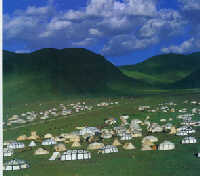| |
Tibetan Houses
( 2005-10-27 )
Black yak wool tent
 To make a black yak wool tent, people use yak wool to make big ropes first, and then tie the ropes together. A good size tent, which covers about 28 square meters, requires about 90 kilograms of wool. The tent is square at the base with a window at the top that let smoke out and sunlight in. On a snowy day, the window can be shut. To make a black yak wool tent, people use yak wool to make big ropes first, and then tie the ropes together. A good size tent, which covers about 28 square meters, requires about 90 kilograms of wool. The tent is square at the base with a window at the top that let smoke out and sunlight in. On a snowy day, the window can be shut.
The front part of the tent is split into two pieces to make a door. There is neither a bed nor a chair inside a tent. Rather, people sit on carpets and cushions. In the middle of the tent, an earthy fireplace is set up. Behind the fireplace, there are fuels (yak dung).
The tent is naturally divided into two quarters. Males occupy the left half, and females the right half. The inner part of the left side is the worshiping place equipped with Buddha statues, scripts, and lamps. The right side is for utensils and food storage.
Outside the tent, sometimes people build a wall of sod or dung to guard the animals or protect them against cold wind.
White cloth tent
Usually, the pastoral people have a couple of white cloth tents. These tents are smaller and elegant, good for traveling. In a religious or racing gathering, people come with white cloth tents. The elders, teens, and guests usually stay in this kind of tents. The fireplace is usually outside the tent. There are big hexagonal tents, well decorated with religious signs, mainly around monasteries or for the use of religious occasions.
|
|

